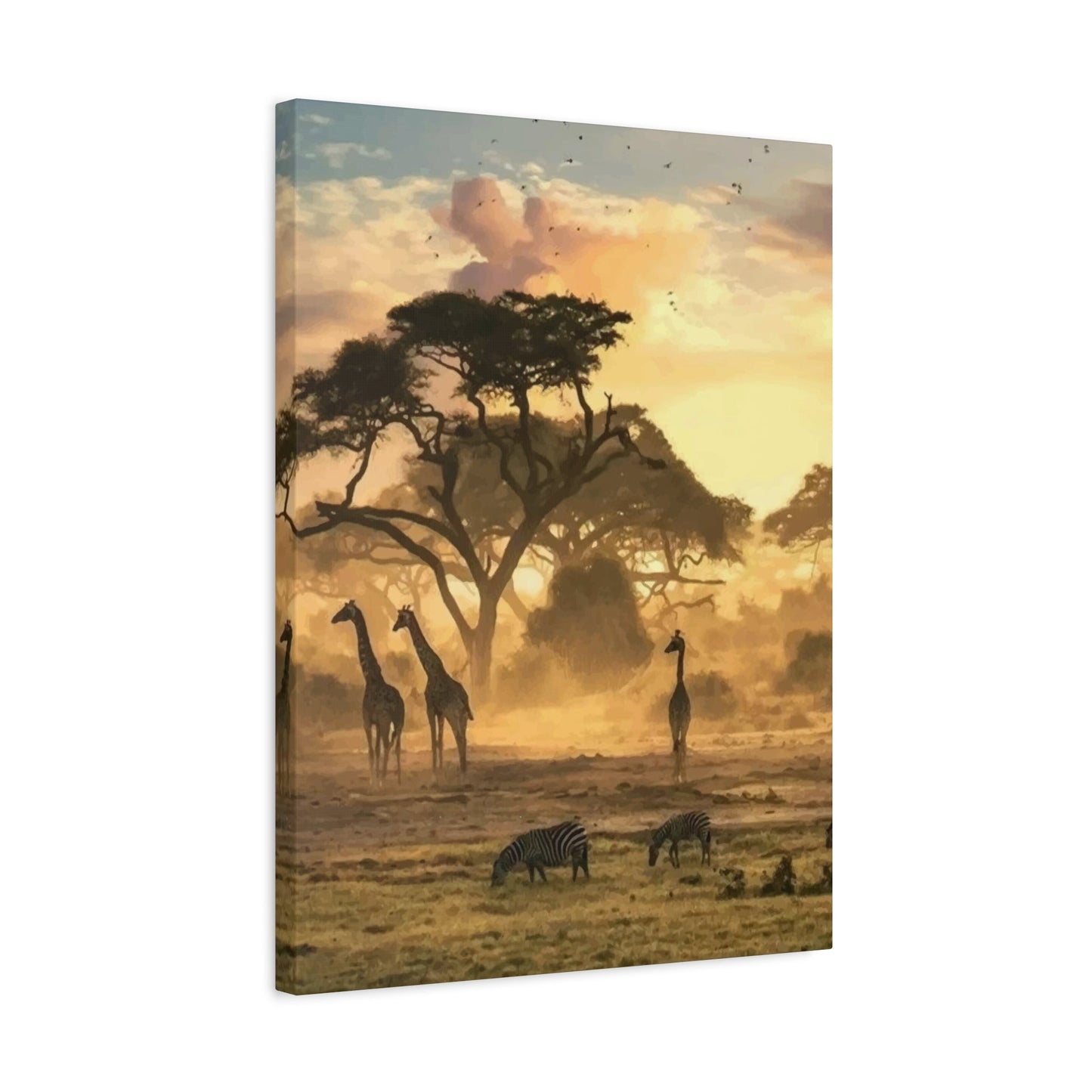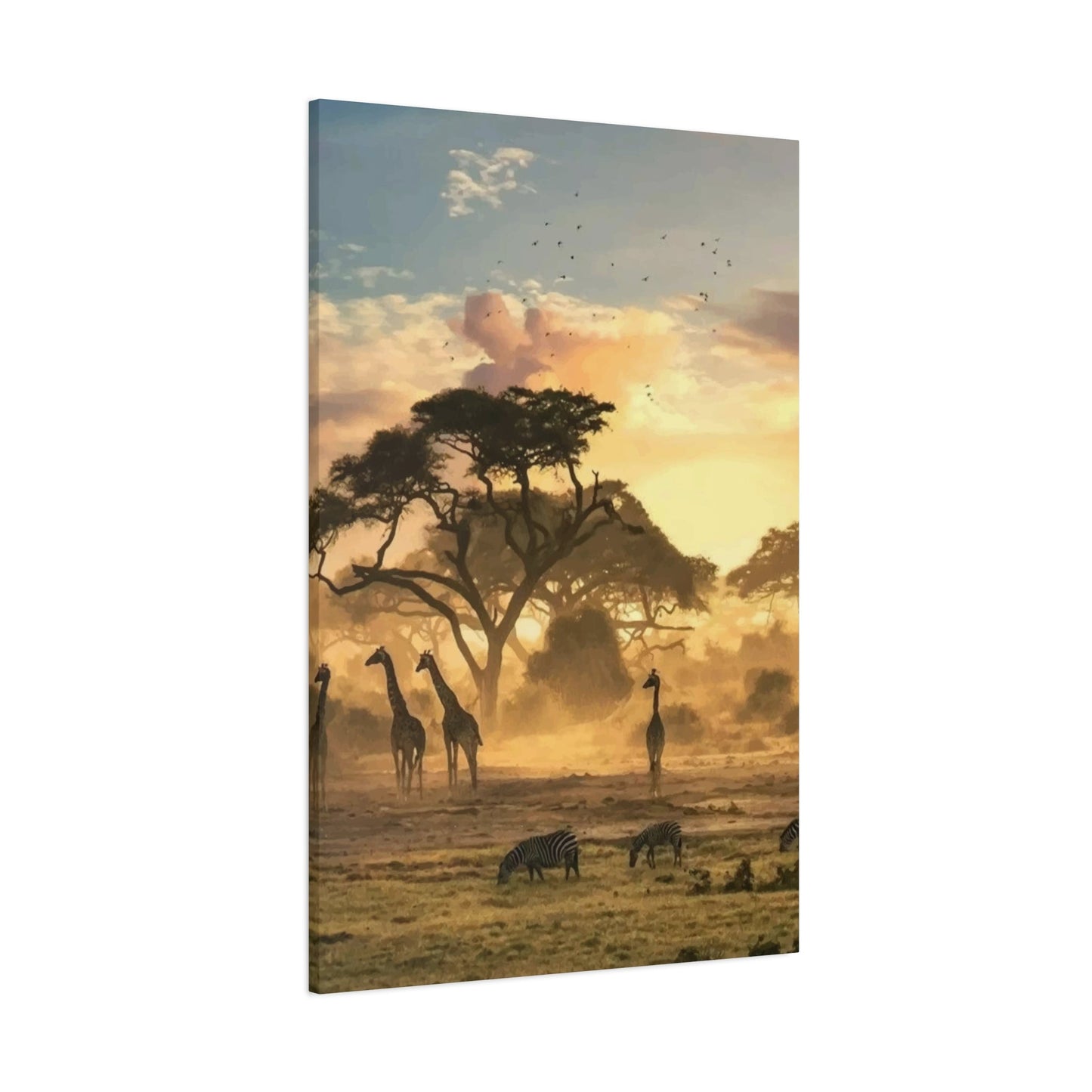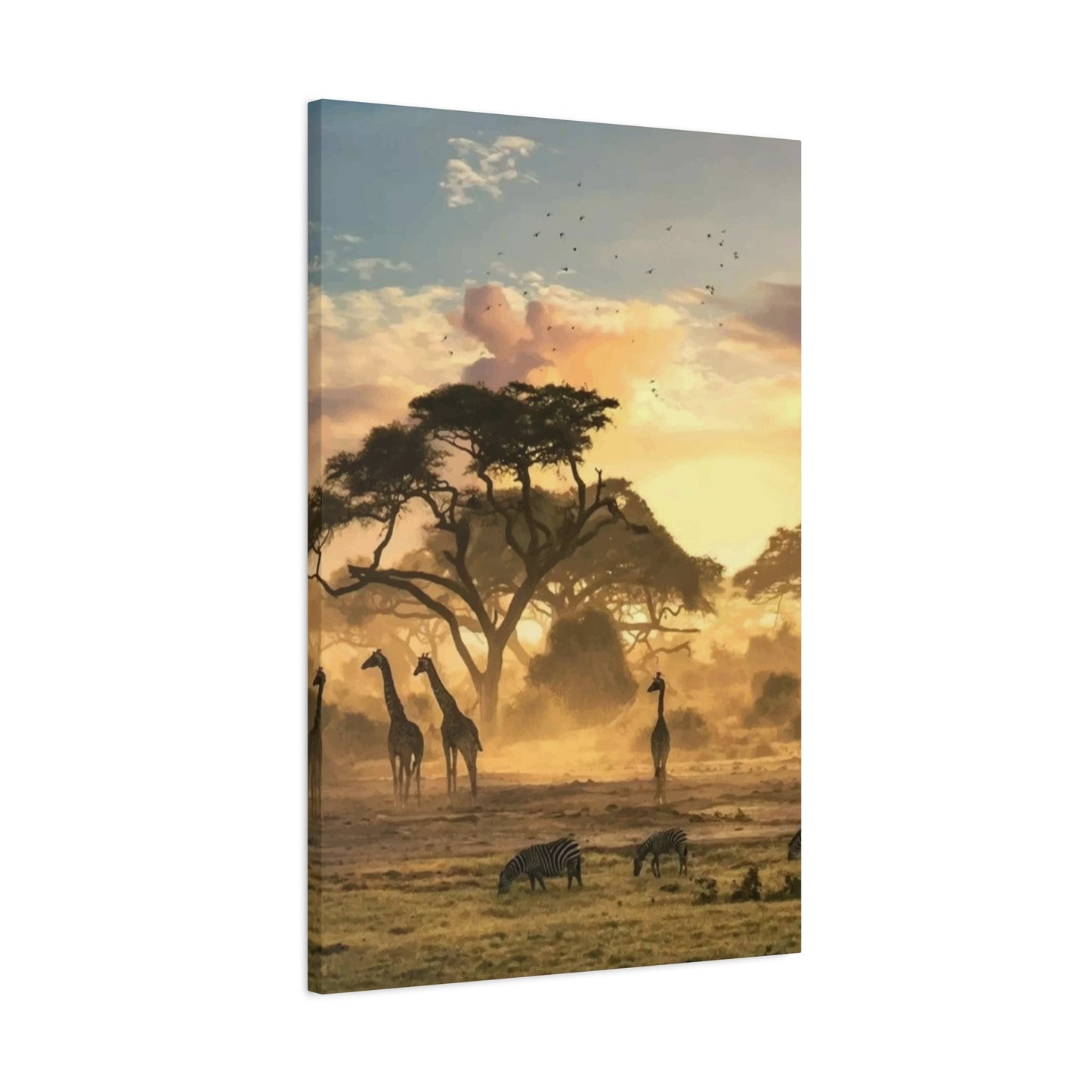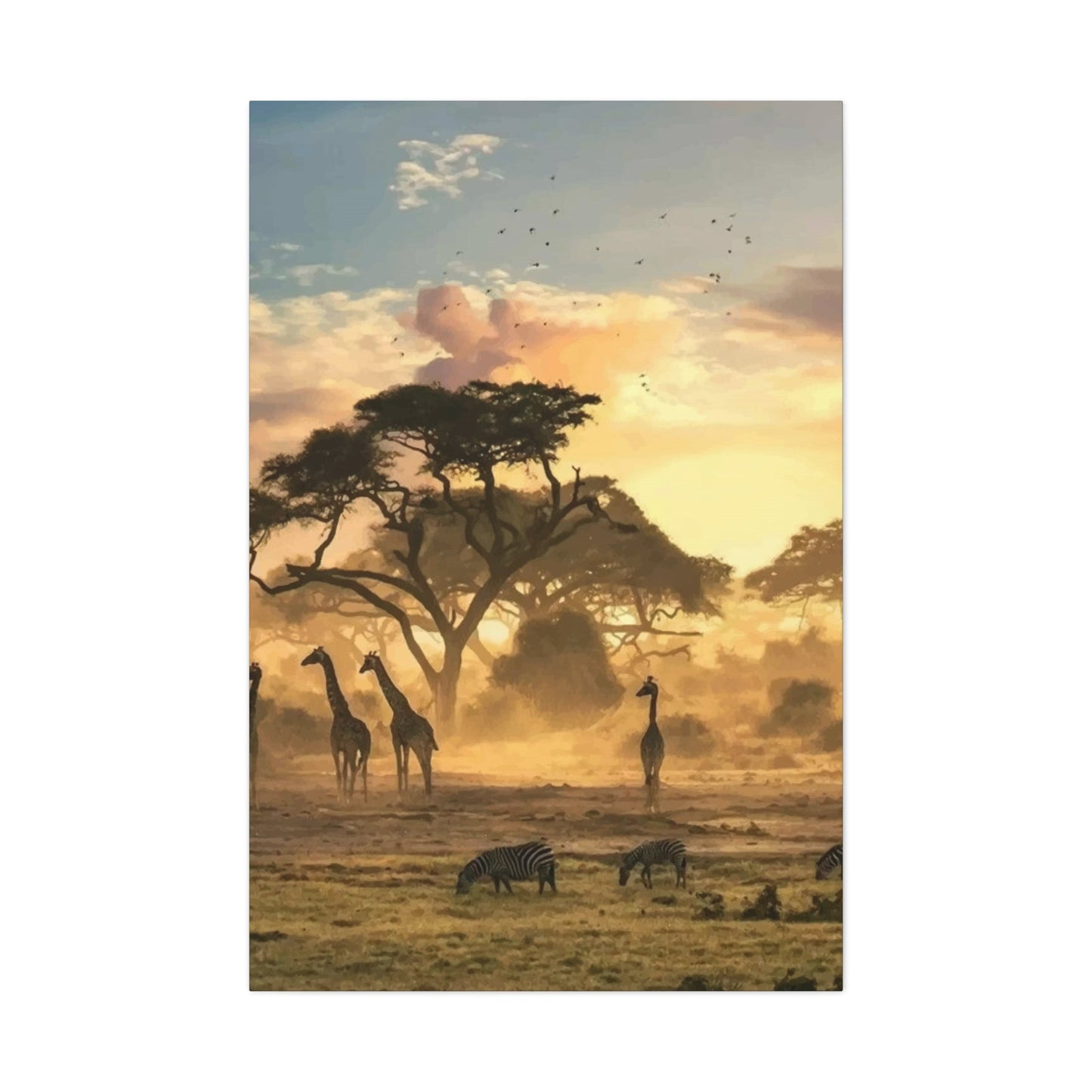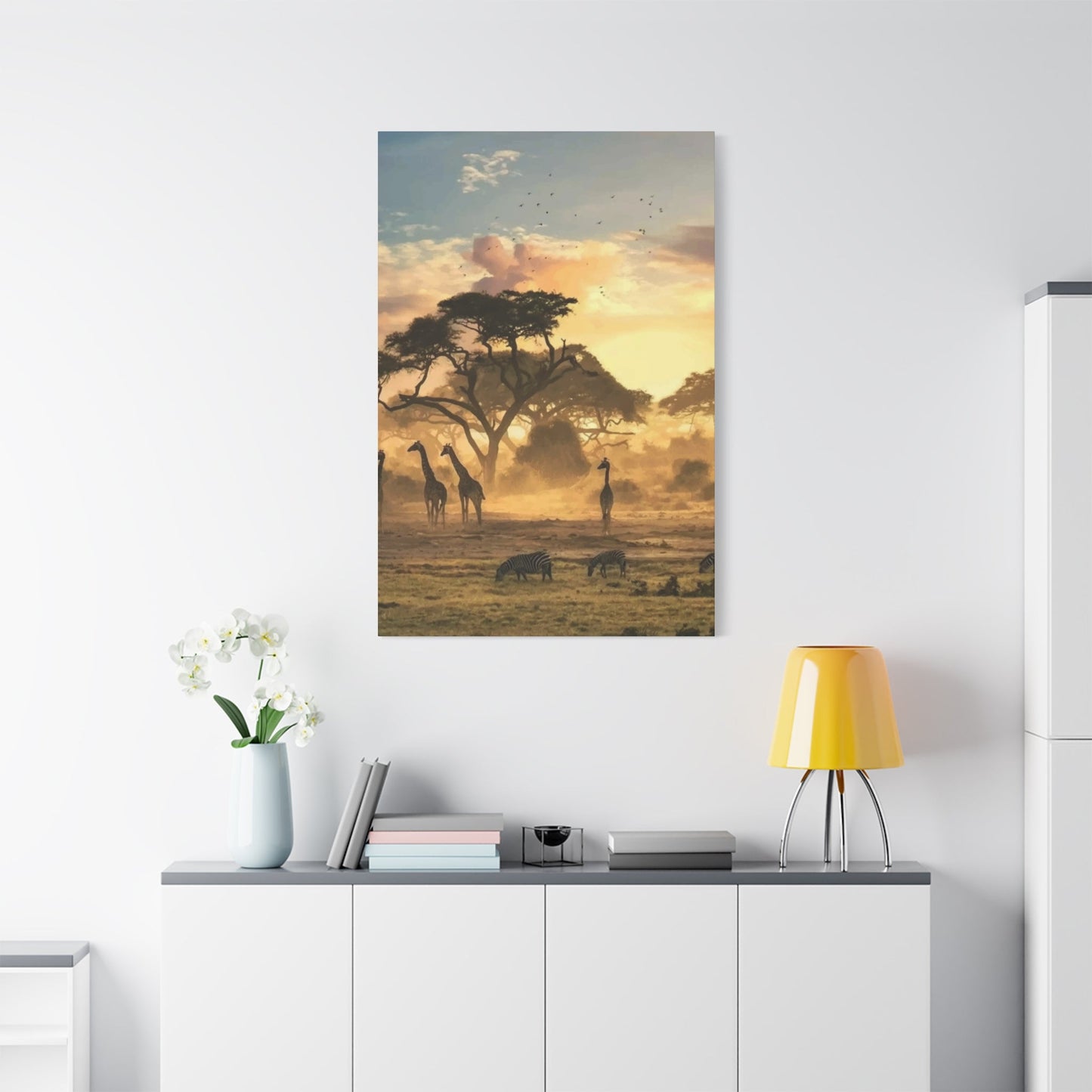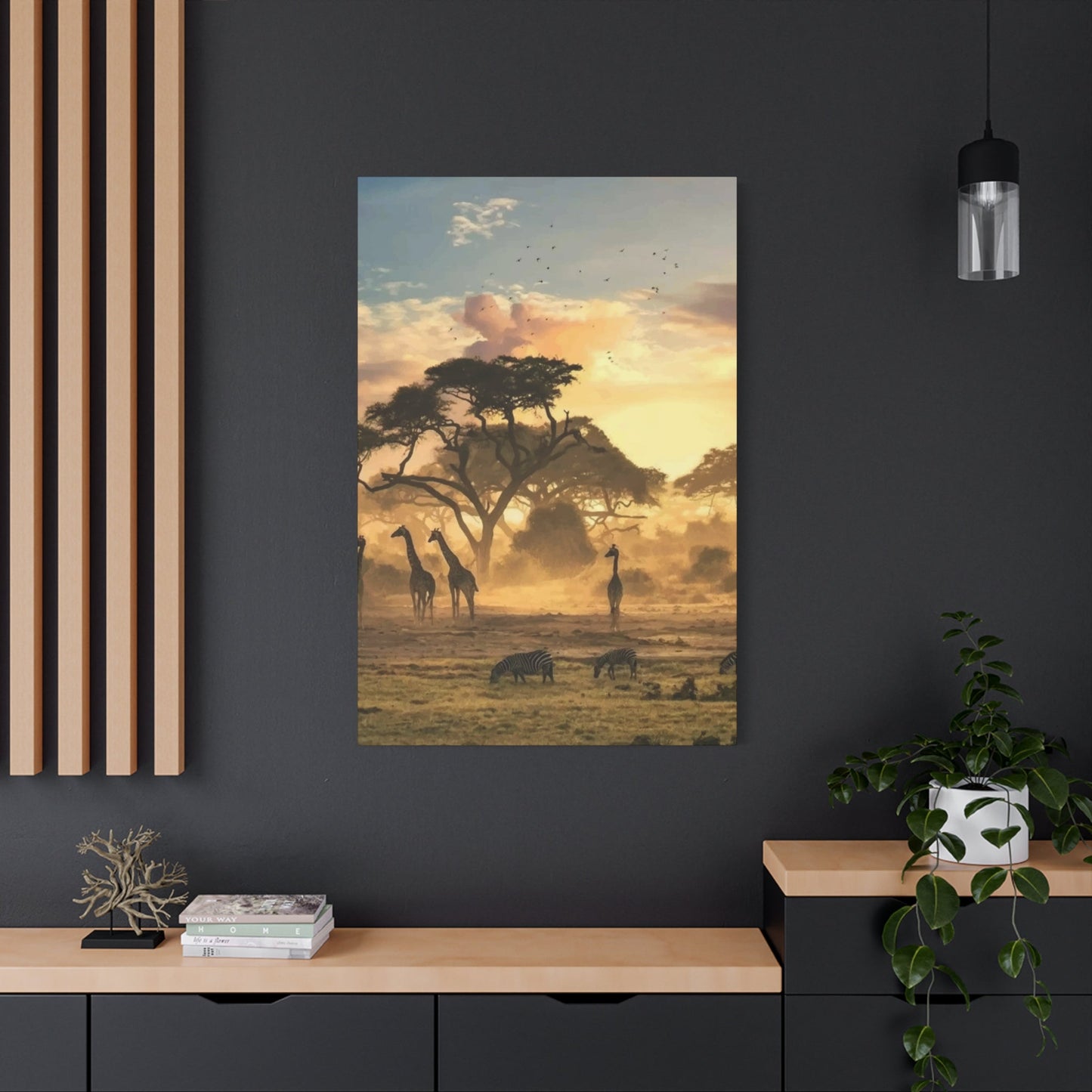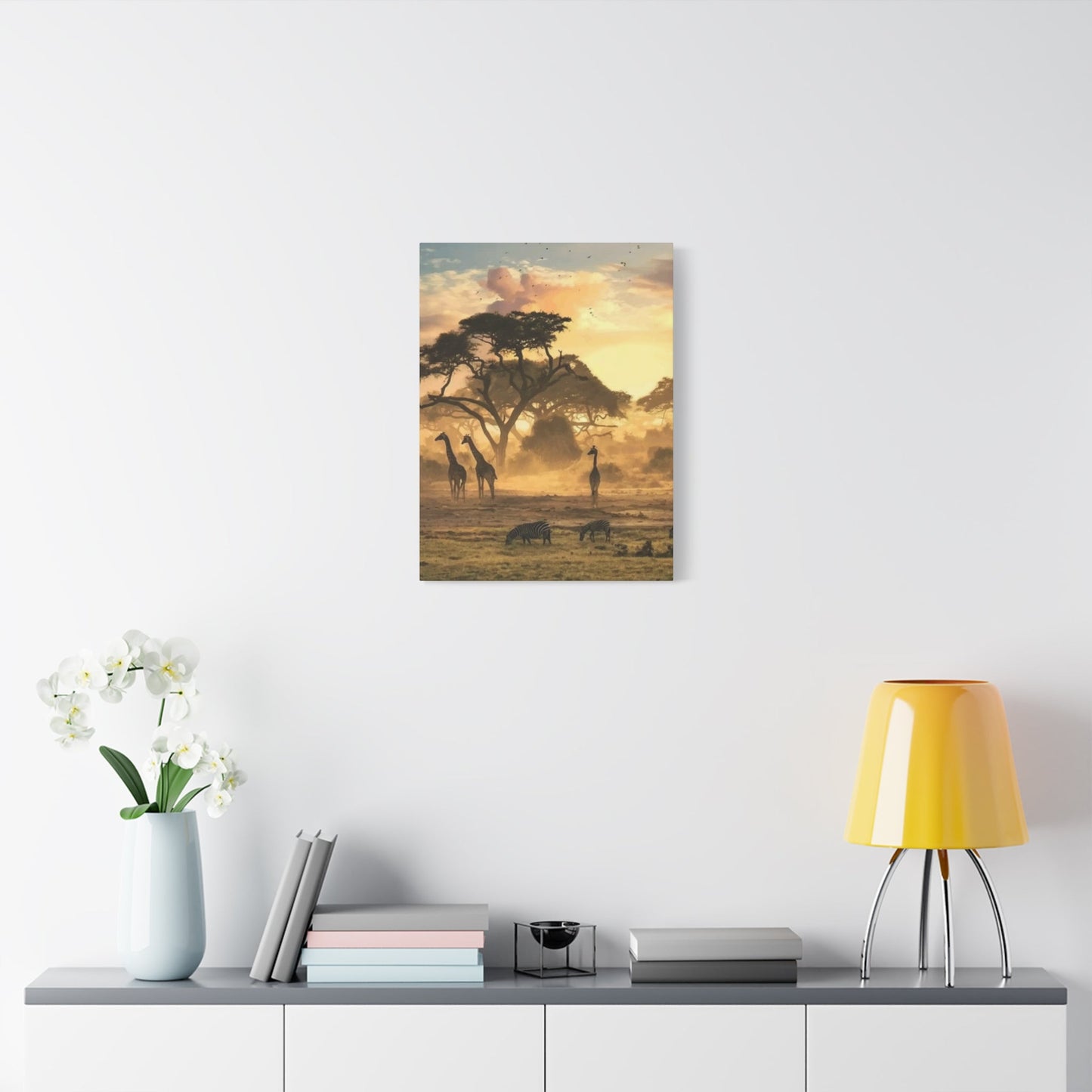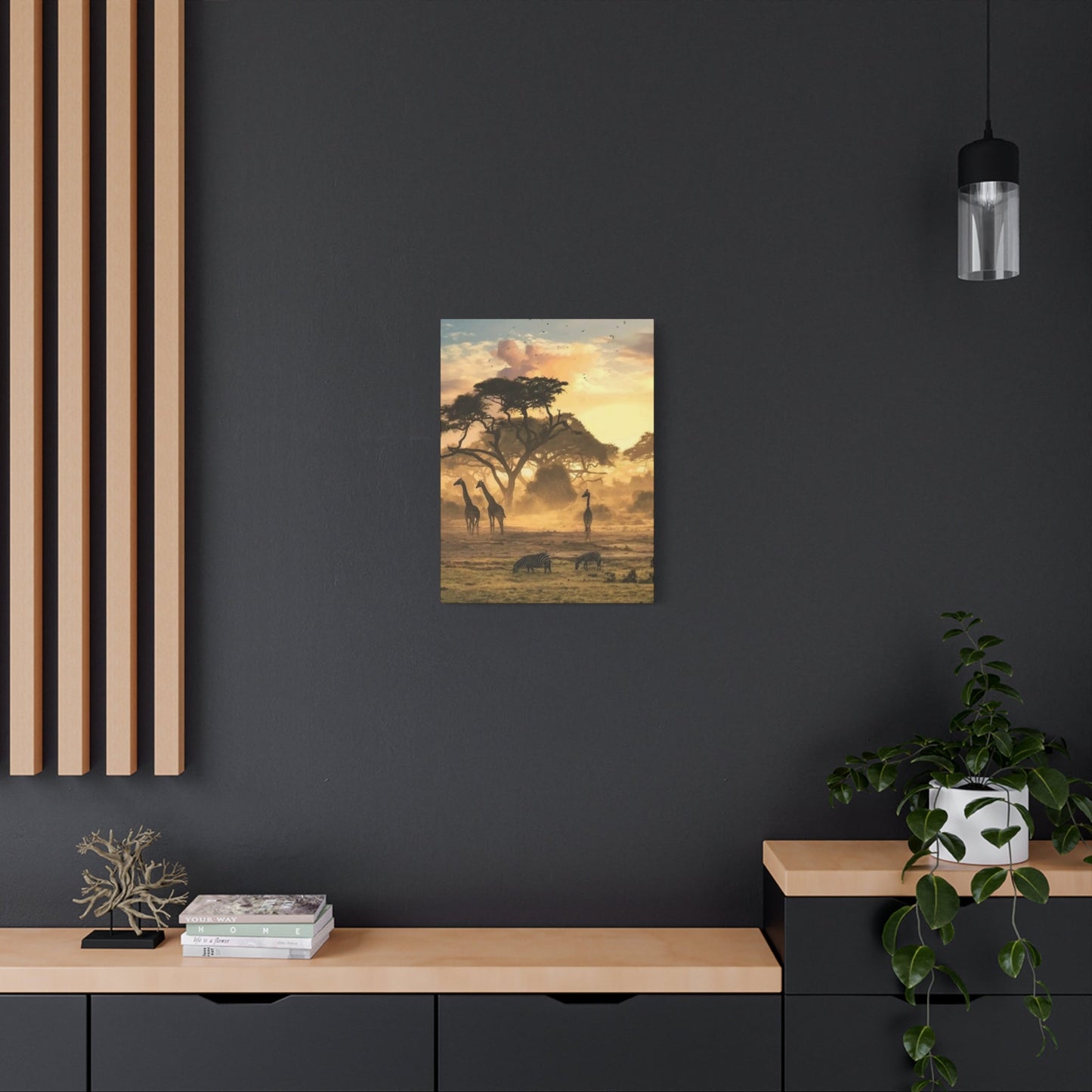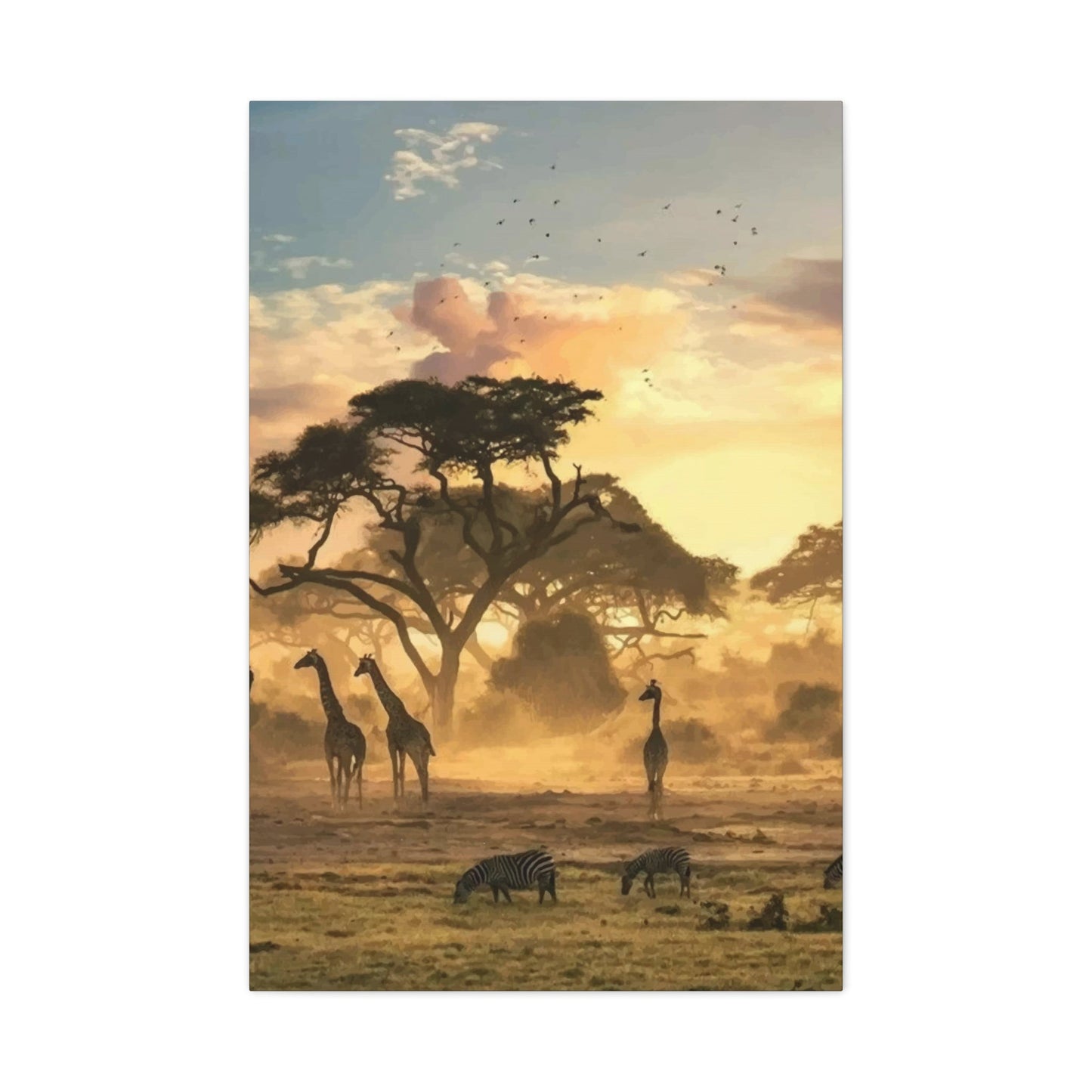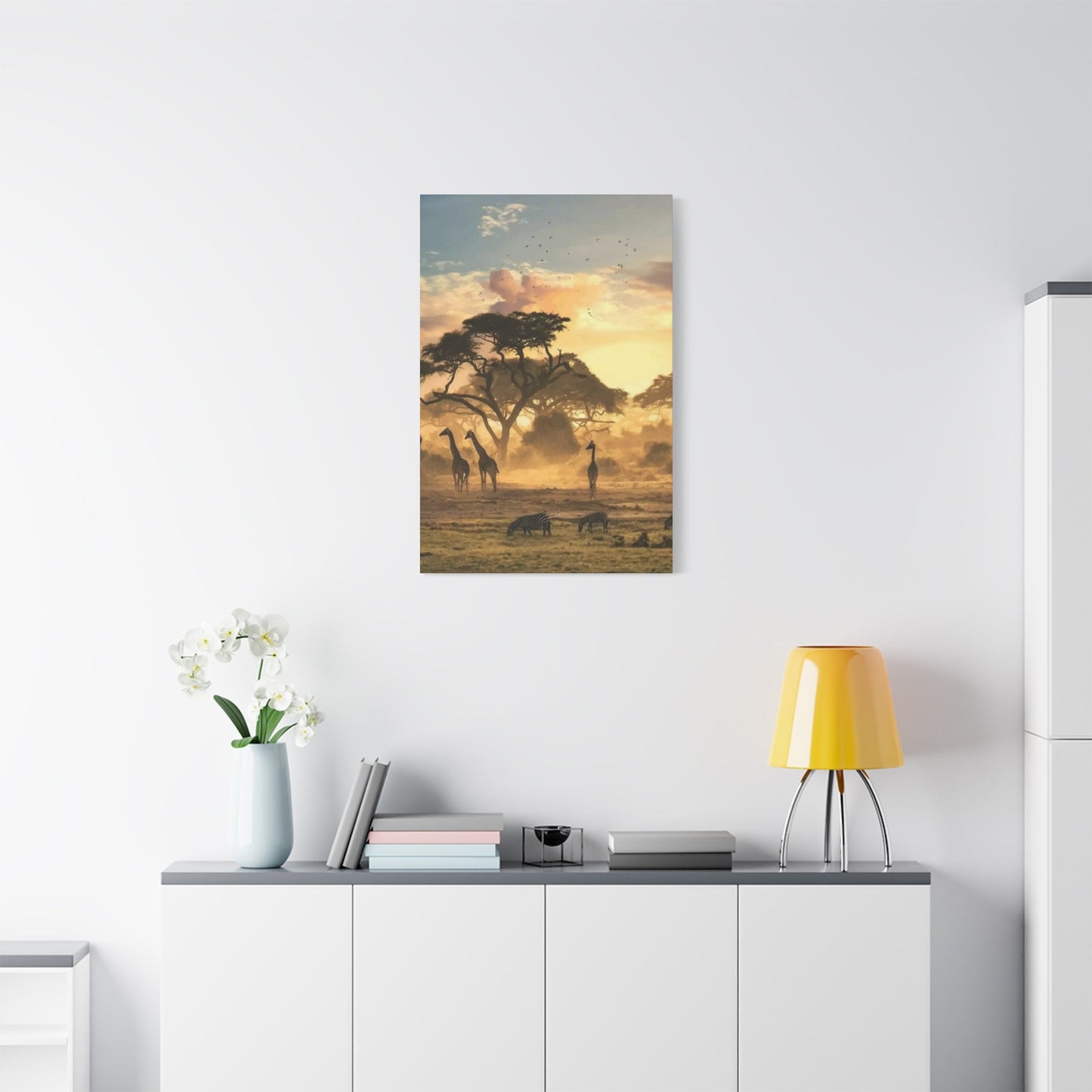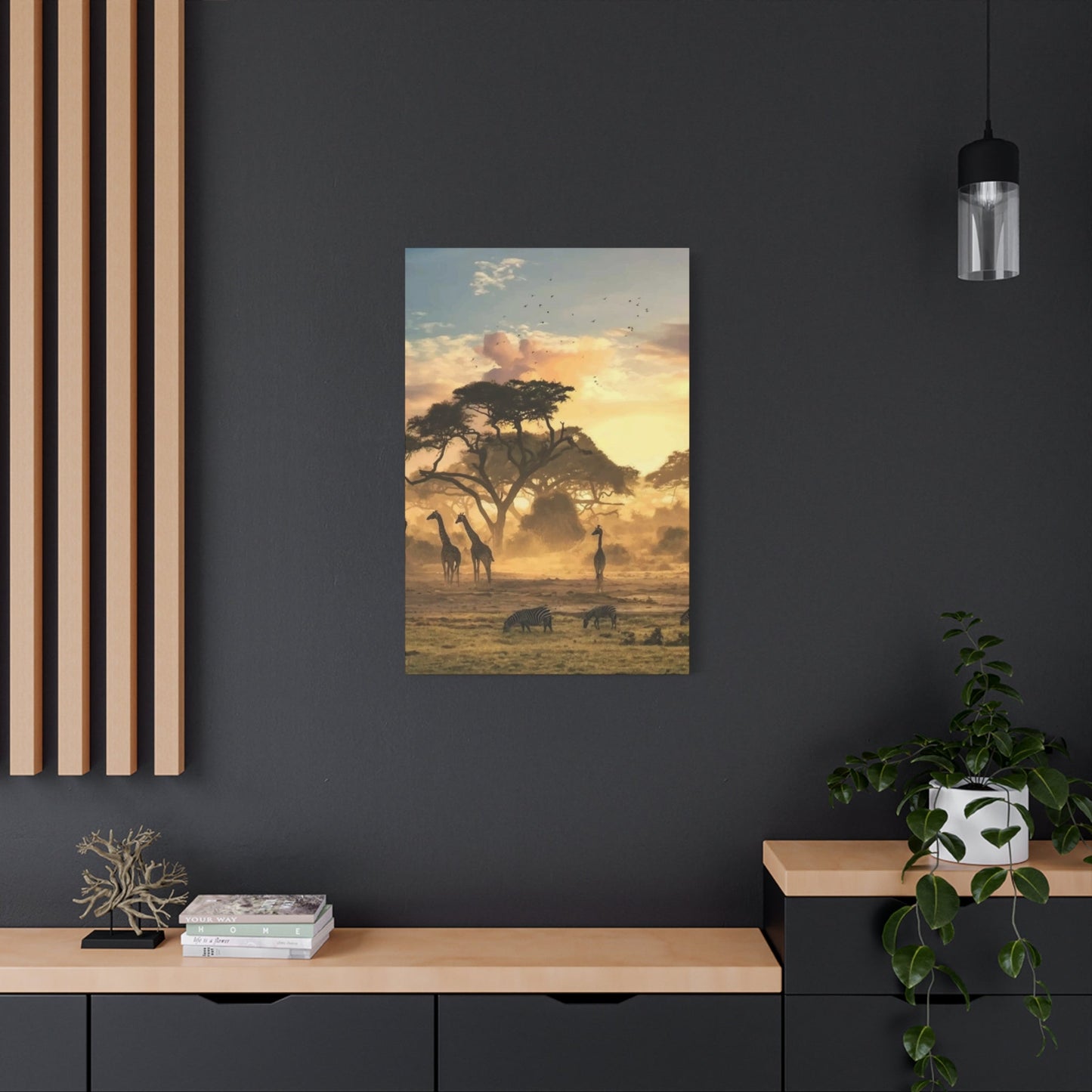African Jungle Canvas Prints for Small Spaces: Choosing the Right Sizes and Styles
The allure of African artistry has captivated homeowners and interior designers worldwide, offering a unique blend of natural beauty, rich cultural heritage, and contemporary design elements. African safari canvas prints represent more than mere decoration; they serve as windows into a continent's soul, bringing the untamed wilderness and vibrant traditions directly into modern living spaces. These carefully curated pieces transform ordinary walls into extraordinary galleries that celebrate the diversity, power, and mystique of Africa.
Modern homes increasingly embrace global influences, and African-inspired wall decor stands at the forefront of this movement. The continent's vast landscapes, from rolling savannahs to dense jungles, provide endless inspiration for artists and photographers who capture these moments in stunning canvas prints. Whether depicting the graceful stride of a giraffe against a blazing sunset or the intricate patterns of traditional tribal textiles, each piece tells a story that resonates with viewers on multiple levels.
The growing popularity of African safari canvas prints stems from their ability to create focal points that spark conversation while maintaining sophistication. These artworks seamlessly blend with various interior design styles, from minimalist modern spaces to eclectic bohemian environments. The organic shapes, earthy color palettes, and dynamic compositions found in African-inspired art offer a refreshing contrast to the sterile environments often associated with contemporary living.
Interior designers recognize the transformative power of authentic African wall decor, utilizing these pieces to inject personality and warmth into residential and commercial spaces. The visual impact of a well-placed canvas featuring African wildlife or cultural scenes can instantly elevate a room's aesthetic appeal while creating an atmosphere of adventure and worldly sophistication. This comprehensive guide explores the vast world of African safari canvas prints, offering insights into selection, placement, and styling to help create spaces that honor the continent's artistic legacy.
Vibrant African Safari Canvas Prints for Modern Homes
Contemporary interior design increasingly embraces the raw beauty and untamed spirit found in vibrant African safari canvas prints, which serve as powerful statements in modern homes. These carefully selected artworks bring the excitement of African wilderness directly into living spaces, creating focal points that capture attention while maintaining sophisticated appeal. The natural color palettes found in safari prints complement modern design principles, offering warm earth tones, rich ochres, and deep sunset hues that balance contemporary furniture and architectural elements.
Modern homeowners gravitate toward African safari prints because they provide visual interest without overwhelming minimalist aesthetics. The organic forms and flowing lines characteristic of safari landscapes create pleasing contrasts against clean geometric furniture and structured room layouts. Large-format canvas prints featuring expansive savannah vistas or intimate wildlife encounters transform plain walls into conversation-starting galleries that reflect the homeowner's appreciation for natural beauty and cultural diversity.
The versatility of safari canvas prints allows them to function effectively in various room settings throughout modern homes. Living rooms benefit from statement pieces depicting dramatic African sunsets or herds of migrating animals, while bedrooms become serene retreats with gentle landscape scenes or peaceful wildlife portraits. Kitchen and dining areas gain warmth through smaller prints featuring African flora or traditional scenes that celebrate the continent's agricultural heritage.
Quality safari canvas prints demonstrate remarkable durability and color retention, making them excellent long-term investments for modern homes. Advanced printing processes ensure that the vibrant colors and fine details characteristic of African landscapes remain sharp and vivid for years. The canvas medium itself provides texture and depth that photographic prints cannot match, creating an almost three-dimensional quality that draws viewers into the scene.
Selecting the right safari canvas prints requires consideration of existing color schemes and design elements within modern homes. Warm-toned prints featuring golden grasslands and amber sunsets complement neutral color palettes, while cooler prints depicting misty mornings or shadowed forests work well with contemporary gray and blue schemes. The key lies in choosing pieces that enhance rather than compete with existing design elements.
Professional framing and mounting significantly impact the overall presentation of safari canvas prints in modern settings. Floating frames create clean lines that align with contemporary design principles, while allowing the artwork to appear suspended within the frame structure. Gallery-style hanging systems enable easy rotation of prints, allowing homeowners to refresh their decor seasonally or according to changing preferences.
Tribal Patterns in African Wall Art
Traditional tribal patterns represent centuries of cultural expression and storytelling, making them compelling subjects for contemporary African wall art that bridges ancient wisdom with modern design sensibilities. These intricate geometric designs carry deep symbolic meanings within African cultures, representing everything from spiritual beliefs to social status, family lineage, and connection to the natural world. When translated onto canvas for modern wall art, these patterns maintain their cultural significance while adapting to contemporary interior design requirements.
The mathematical precision and symbolic complexity found in African tribal patterns create visually striking wall art that functions effectively in modern spaces. Bold geometric shapes, repetitive motifs, and carefully balanced compositions provide the visual structure that contemporary interiors require while introducing elements of cultural depth and historical significance. These patterns work particularly well in spaces that benefit from strong graphic elements, such as offices, lobbies, and modern living areas with minimalist furnishings.
Color plays a crucial role in authentic tribal pattern wall art, with traditional palettes featuring earth tones, ochres, deep reds, and natural blacks that reflect the pigments historically available to African artists. Modern interpretations may incorporate contemporary color schemes while maintaining the essential character and proportional relationships that define specific tribal artistic traditions. This flexibility allows tribal pattern wall art to complement various interior design schemes without compromising cultural authenticity.
Different African tribes have developed distinctive pattern vocabularies that reflect their unique cultural perspectives and environmental influences. Kente cloth patterns from Ghana feature complex geometric arrangements in vibrant colors, while Ndebele designs from South Africa emphasize bold linear elements and contrasting color combinations. Understanding these cultural distinctions helps homeowners select tribal pattern wall art that resonates with their personal aesthetic preferences while honoring the source cultures.
The scale of tribal patterns requires careful consideration when selecting wall art for modern homes. Large-scale patterns work effectively as statement pieces in spacious rooms with high ceilings, while smaller, more intricate patterns suit intimate spaces or gallery wall arrangements. The repetitive nature of many tribal patterns allows for creative cropping and arrangement possibilities that can adapt to various wall dimensions and room proportions.
Contemporary artists working with tribal patterns often explore innovative presentation methods that respect traditional designs while appealing to modern sensibilities. Mixed media approaches might combine traditional patterns with contemporary materials, while digital manipulation allows for color variations and scale adjustments that maintain pattern integrity while suiting specific interior requirements. These modern interpretations expand the possibilities for incorporating tribal patterns into contemporary wall art collections.
Abstract African Landscapes on Canvas
Abstract interpretations of African landscapes offer contemporary art enthusiasts the opportunity to experience the continent's natural beauty through a modern artistic lens that emphasizes emotional response over literal representation. These canvas works distill the essence of African terrain into essential elements of color, form, and texture, creating pieces that suggest rather than explicitly depict the vast savannahs, rolling hills, and dramatic skies that define much of the African continent. This approach allows viewers to engage with the artwork on a more personal level, projecting their own experiences and emotions onto the abstract forms.
The color palettes employed in abstract African landscape canvas works reflect the natural tones found across the continent's diverse geographical regions. Warm oranges and deep reds evoke the intensity of African sunsets, while muted greens and browns suggest the subtle variations in grassland and scrub vegetation. Cool blues and purples capture the atmospheric effects of distance and elevation, creating depth and movement within the abstract compositions. These carefully chosen color relationships maintain connections to the natural world while allowing for artistic interpretation and emotional expression.
Textural elements play a significant role in successful abstract African landscape canvas works, with artists employing various techniques to suggest the tactile qualities of different terrain types. Rough brushwork might represent rocky outcroppings or tree bark, while smooth color transitions evoke vast sky expanses or still water surfaces. Mixed media approaches incorporating sand, fabric, or other materials add authentic textural references that connect abstract compositions to their geographical inspirations.
The compositional structures of abstract African landscape canvas works often reflect the horizontal emphasis of much African terrain, with strong linear elements suggesting horizons, distant mountain ranges, or the meeting points between earth and sky. These horizontal divisions create natural focal points while providing visual stability that works well in contemporary interior settings. Vertical elements, when present, might suggest individual trees, rock formations, or atmospheric effects like rain or dust storms.
Contemporary collectors appreciate abstract African landscape canvas works for their ability to function as both artistic statements and cultural bridges. These pieces allow viewers to connect with African landscapes without requiring specific geographical knowledge or cultural context, making them accessible to diverse audiences while maintaining meaningful connections to their source inspirations. The abstract nature of these works also ensures their compatibility with various interior design styles and color schemes.
The emotional resonance of abstract African landscape canvas works often surprises viewers who initially approach them as purely decorative elements. The primal power of African landscapes translates effectively through abstract interpretation, creating pieces that evoke feelings of freedom, adventure, and connection to the natural world. This emotional impact makes abstract landscape canvas works particularly effective in spaces designed for relaxation, contemplation, or creative inspiration.
African Wildlife Art for Living Rooms
Living rooms serve as the primary gathering spaces in most homes, making them ideal locations for impactful African wildlife art that creates conversation starters while reflecting the homeowner's appreciation for natural beauty and global consciousness. The majestic presence of African animals translates powerfully onto canvas, bringing the drama and wonder of wildlife encounters into domestic settings where they can be appreciated daily. These artistic representations serve multiple functions, acting as decorative elements, educational tools, and windows into the natural world that many will never experience firsthand.
The selection of African wildlife art for living rooms requires careful consideration of scale, subject matter, and visual impact to ensure the pieces enhance rather than overwhelm the space. Large canvas prints featuring iconic animals like elephants, lions, or giraffes work effectively as statement pieces above sofas or fireplace mantels, while smaller prints can be grouped to create gallery walls that tell comprehensive stories about African biodiversity. The key lies in balancing visual drama with living room functionality and comfort.
Color coordination between wildlife art and existing living room decor determines the success of these artistic installations. Many African animals feature neutral color palettes that complement contemporary furniture and architectural elements, while their natural habitats provide earth tones that work well with various interior design schemes. The warm browns and golden tones found in many wildlife photographs create inviting atmospheres that encourage relaxation and social interaction.
Different artistic styles in wildlife representation offer various aesthetic options for living room decoration. Photorealistic paintings and high-quality photographic prints provide detailed views of animal behavior and characteristics, appealing to nature enthusiasts and educational purposes. Stylized or impressionistic interpretations offer more artistic freedom and can better complement modern furniture styles while maintaining the essential character of the depicted animals.
The positioning of wildlife art within living rooms significantly impacts its effectiveness and the room's overall atmosphere. Eye-level placement ensures comfortable viewing for seated guests, while slightly higher positioning can create more dramatic impact and prevent the artwork from competing with furniture arrangements. Proper lighting, whether natural or artificial, enhances the visual impact of wildlife art and helps create the desired mood within the living space.
Grouping multiple wildlife pieces creates opportunities for storytelling and visual continuity that single large pieces cannot provide. Safari-themed collections might progress from landscape establishing shots to intimate animal portraits, creating narrative sequences that guide viewers through imaginary wildlife encounters. These grouped arrangements work particularly well in larger living rooms where wall space allows for comprehensive artistic displays.
Cultural Heritage in African Wall Decor
African wall decor that celebrates cultural heritage brings depth, meaning, and historical context to modern interior spaces while honoring the rich traditions and artistic legacy of the continent's diverse peoples. These carefully selected pieces serve as cultural ambassadors, introducing viewers to the sophisticated artistic traditions, spiritual beliefs, and social structures that have flourished across Africa for millennia. Unlike purely decorative elements, heritage-focused wall decor carries educational and emotional weight that transforms living spaces into informal cultural centers.
Traditional African art forms have been adapted for contemporary wall decor applications while maintaining their essential cultural integrity and symbolic significance. Carved wooden masks, textile patterns, beadwork designs, and ceremonial objects provide inspiration for modern canvas interpretations that make these cultural treasures accessible to broader audiences. The transition from three-dimensional cultural artifacts to wall-mounted art requires careful consideration of how to preserve meaning while adapting to new presentation formats.
The symbolic languages embedded in traditional African cultural artifacts translate effectively to wall decor when creators understand and respect their original contexts. Protective symbols, fertility representations, spiritual guides, and social status indicators all carry specific meanings that enhance the viewing experience for educated audiences while providing visual appeal for casual observers. This dual function makes heritage-based wall decor particularly valuable for spaces where cultural education and aesthetic appeal must coexist.
Regional variations in African cultural expression provide extensive inspiration for diverse wall decor collections that represent the continent's incredible cultural diversity. West African Kente patterns differ significantly from East African beadwork traditions, while Central African mask designs reflect entirely different spiritual and social concepts than Southern African pottery decorations. Understanding these regional distinctions helps creators and collectors build coherent yet diverse cultural displays.
Contemporary artists working with African cultural heritage themes often employ modern materials and presentation methods while maintaining respect for traditional artistic principles. Digital printing allows for accurate reproduction of textile patterns and mask designs, while contemporary framing and mounting options ensure these pieces integrate successfully with modern interior design schemes. The challenge lies in balancing accessibility with authenticity and respect for source cultures.
The educational value of heritage-focused African wall decor extends beyond mere aesthetic appreciation, offering opportunities for cultural learning and cross-cultural understanding. Information about the cultural contexts, symbolic meanings, and traditional uses of depicted artifacts can transform decorative installations into informal educational displays that promote cultural awareness and appreciation. This educational dimension adds lasting value to heritage-based wall decor investments.
Maasai-Inspired Wall Art Prints
The distinctive visual culture of the Maasai people of East Africa provides compelling inspiration for contemporary wall art prints that celebrate one of the continent's most recognizable indigenous communities. Maasai artistic traditions encompass intricate beadwork, vibrant textiles, distinctive jewelry designs, and architectural elements that translate beautifully to modern wall art formats. These prints honor Maasai cultural heritage while making their artistic traditions accessible to global audiences who appreciate both aesthetic beauty and cultural significance.
Traditional Maasai color palettes feature bold combinations of red, blue, yellow, and white that create striking visual impact in contemporary interior settings. Red holds particular significance in Maasai culture, representing bravery, strength, and cultural unity, while blue symbolizes the sky and divine protection. These symbolic color relationships add depth and meaning to wall art prints while providing designers with powerful tools for creating dramatic interior focal points.
Beadwork patterns represent perhaps the most recognizable element of Maasai artistic expression, with complex geometric designs that communicate social status, age group, and cultural identity within the community. When adapted for wall art prints, these patterns maintain their visual power while becoming accessible decorative elements that work effectively in modern homes and offices. The mathematical precision and balanced proportions found in traditional beadwork translate well to contemporary design principles.
Portrait-style prints featuring Maasai individuals in traditional dress and adornment offer viewers intimate glimpses into this distinctive culture while celebrating the dignity and beauty of indigenous peoples. These artistic representations require careful handling to avoid cultural appropriation while maintaining respect for the depicted subjects and their cultural context. Successful portrait prints balance aesthetic appeal with cultural sensitivity and educational value.
The architectural elements of traditional Maasai settlements, including the distinctive rounded structures and geometric fence patterns, provide additional inspiration for wall art prints that explore the relationship between human settlements and natural environments. These architectural themes work particularly well in modern homes where they can suggest connections between contemporary living and traditional building practices that emphasize sustainability and harmony with natural surroundings.
Contemporary interpretations of Maasai artistic traditions often employ modern printing and presentation methods while maintaining the essential visual elements that define this cultural aesthetic. High-quality canvas printing preserves the vibrant colors and fine details characteristic of traditional Maasai art, while contemporary framing options ensure these pieces integrate successfully with various interior design styles. The key lies in honoring traditional artistic principles while adapting to modern presentation requirements.
Serengeti Sunsets on Canvas
The legendary sunsets of the Serengeti represent some of nature's most spectacular daily performances, creating dramatic skies that have inspired artists, photographers, and travelers for generations. Canvas prints featuring these magnificent atmospheric displays bring the romance and grandeur of East African evenings into interior spaces where they serve as daily reminders of natural beauty and the passage of time. These sunset scenes work particularly effectively in residential settings where they create calming, contemplative atmospheres that encourage relaxation and reflection.
The color progressions characteristic of Serengeti sunsets provide rich palettes that complement various interior design schemes while maintaining their natural beauty and emotional impact. Deep oranges and brilliant reds dominate the sky during peak sunset moments, while softer pinks and purples characterize the transitional periods before and after the main event. These warm tones create inviting atmospheres in living spaces while providing visual connections to the natural world.
Atmospheric effects unique to the Serengeti environment, including dust particles, scattered clouds, and varying humidity levels, create distinctive sunset characteristics that distinguish these scenes from other geographical regions. Artists and photographers working in this environment must understand these atmospheric conditions to capture authentic representations that convey the specific beauty of Serengeti evenings. Canvas prints that successfully reproduce these atmospheric effects provide viewers with genuine connections to this iconic landscape.
The foreground elements typically featured in Serengeti sunset canvas prints add contextual information and visual interest that enhance the overall composition. Silhouetted acacia trees create recognizable African shapes against dramatic skies, while distant hills and grasslands provide geographical context that helps viewers understand the scale and scope of this vast ecosystem. These foreground elements also provide compositional anchor points that balance the dynamic energy of sunset skies.
Wildlife elements often integrated into Serengeti sunset scenes create narrative tension and visual interest that pure landscape compositions cannot achieve. Elephants walking across the horizon, giraffes feeding among acacia trees, or herds of wildebeest moving through grasslands add life and movement to sunset scenes while emphasizing the interconnected nature of this remarkable ecosystem. These combined wildlife and landscape compositions work particularly well in spaces where natural history and aesthetic beauty intersect.
The emotional resonance of Serengeti sunset canvas prints extends beyond their immediate visual appeal, often evoking feelings of wanderlust, peace, and connection to larger natural cycles. These emotional responses make sunset prints particularly effective in bedrooms, meditation spaces, and other areas designed for relaxation and personal reflection. The daily cycle represented by sunset imagery also provides metaphorical connections to human experiences of transition, renewal, and the passage of time.
African Elephants: Majestic Canvas Art
African elephants represent the pinnacle of wildlife majesty, making them compelling subjects for canvas art that celebrates both natural beauty and conservation awareness. These magnificent creatures embody qualities that resonate deeply with human observers: intelligence, family loyalty, emotional depth, and peaceful strength. Canvas prints featuring African elephants serve multiple purposes in contemporary interior design, functioning as aesthetic focal points while promoting awareness of wildlife conservation and the natural world's intrinsic value.
The physical characteristics that make elephants such impressive subjects for canvas art include their massive scale, distinctive silhouettes, and expressive features that convey personality and emotion. Artists working with elephant subjects must understand how to capture these qualities effectively, whether through close-up portraits that emphasize individual character or wider shots that demonstrate the animals' relationship with their environment. The textural qualities of elephant skin, the graceful curves of tusks and trunks, and the intelligent expression in their eyes all contribute to compelling artistic representations.
Family dynamics among elephant herds provide rich narrative content for canvas art that goes beyond simple wildlife portraiture. Scenes depicting mothers protecting calves, family groups traveling together, or elephants engaging in social behaviors create emotional connections that enhance the viewing experience. These family-focused compositions work particularly well in residential settings where they can reinforce values of loyalty, protection, and community.
The diverse habitats where African elephants are found offer varied compositional opportunities for canvas art, from the open grasslands of the Serengeti to the dense forests of Central Africa. Each environment provides different lighting conditions, background elements, and atmospheric effects that influence the mood and aesthetic appeal of elephant artwork. Artists must understand how to use these environmental factors to enhance their elephant subjects rather than competing with them for visual attention.
Conservation themes naturally integrate with elephant canvas art, as these magnificent animals face ongoing threats from habitat loss and poaching pressures. Artwork that celebrates elephants while subtly promoting conservation awareness serves dual purposes, providing aesthetic value while encouraging environmental consciousness. This conservation dimension adds meaning and purpose to elephant canvas art that purely decorative pieces cannot provide.
The scale considerations for elephant canvas art require careful planning to ensure these large subjects work effectively in interior spaces. Massive elephants can overwhelm small rooms if not properly proportioned, while tiny elephant images may lose their visual impact in large spaces. Understanding how to balance elephant scale with room dimensions and viewing distances ensures successful artistic installations that honor both the subjects and the interior spaces they occupy.
Colorful African Market Scenes for Home Decor
African marketplace scenes capture the vibrant energy, cultural diversity, and daily rhythms of continental life, making them excellent subjects for home decor that brings warmth, personality, and global consciousness to interior spaces. These bustling environments showcase the intersection of commerce, community, and cultural expression that characterizes much of African urban and rural life. Canvas prints featuring market scenes provide windows into authentic African experiences while adding dynamic visual interest to residential and commercial environments.
The color palettes typically found in African marketplace scenes offer rich inspiration for interior design schemes, featuring combinations of natural earth tones from architectural elements and textiles alongside vibrant colors from displayed goods, clothing, and decorations. Fresh produce markets provide brilliant greens, oranges, and reds from fruits and vegetables, while textile markets showcase the full spectrum of traditional African color preferences. These diverse color combinations work well with various interior design styles while maintaining authentic cultural connections.
Human activity serves as the central focus of most marketplace canvas art, with scenes depicting vendors, shoppers, and community members engaged in daily commercial and social interactions. These human elements create emotional connections that static landscape or object-focused artwork cannot provide, allowing viewers to imagine themselves within these bustling environments. The diversity of people, ages, and activities typically found in African markets provides rich narrative content that enhances the viewing experience.
Architectural elements characteristic of African marketplaces, including traditional building styles, shade structures, and spatial arrangements, provide compositional frameworks that organize complex scenes while maintaining visual coherence. These architectural features often reflect local building traditions and environmental adaptations that add educational value to decorative marketplace artwork. Understanding how architecture influences market activities helps artists create authentic representations that honor both built and social environments.
The merchandise and goods displayed in African marketplace scenes offer opportunities for artists to showcase regional specialties, traditional crafts, and cultural artifacts that represent different African communities. Pottery, textiles, jewelry, wood carvings, and other handcrafted items provide visual detail and cultural context that enrich marketplace compositions. These product displays also demonstrate the skill and creativity of African artisans while promoting appreciation for traditional crafts and techniques.
Contemporary approaches to marketplace canvas art often emphasize the universal aspects of commerce and community while celebrating specifically African characteristics. These artistic interpretations help viewers connect with the human experiences depicted in marketplace scenes while appreciating the unique cultural context that shapes African commercial environments. This balance between universal and specific elements makes marketplace canvas art accessible to diverse audiences while maintaining cultural authenticity.
Minimalist African Silhouette Wall Art
Minimalist approaches to African silhouette wall art distill the continent's distinctive visual elements into essential forms that work effectively with contemporary interior design principles while maintaining cultural connections and aesthetic impact. These simplified artistic representations focus on recognizable shapes, proportions, and compositional relationships rather than detailed surface treatments or complex color schemes. The resulting artwork provides cultural references and visual interest without overwhelming modern interior spaces that emphasize clean lines and uncluttered aesthetics.
Iconic African animal silhouettes, including elephants, giraffes, lions, and antelope, create instantly recognizable forms that communicate African themes without requiring detailed realistic representation. These simplified animal shapes work particularly well in modern interiors where they provide organic contrast to geometric furniture and architectural elements. The universal appeal of animal subjects also makes silhouette art accessible to viewers who may not have extensive knowledge of African culture or wildlife.
Landscape silhouettes featuring distinctive African geographical elements, such as acacia trees, mountain ranges, or architectural structures, provide environmental context that enhances the cultural authenticity of minimalist wall art. These landscape elements work effectively as background components that support focal subjects or as primary compositional elements in their own right. The horizontal emphasis characteristic of many African landscapes translates well to modern interior proportions and wall dimensions.
Human figure silhouettes celebrating African cultural traditions, including dancers, musicians, and people engaged in traditional activities, create dynamic compositions that suggest movement and cultural vitality without requiring detailed representation. These human elements add storytelling dimensions to minimalist wall art while maintaining the visual simplicity that contemporary design requires. The challenge lies in selecting poses and activities that communicate cultural authenticity while remaining visually compelling.
Color strategies for minimalist African silhouette wall art typically employ limited palettes that enhance rather than compete with existing interior design schemes. Monochromatic approaches using single colors or tonal variations provide maximum flexibility for integration with various decorative contexts, while carefully selected accent colors can create focal points or cultural references without overwhelming the minimalist aesthetic. Warm earth tones naturally complement African themes while working well with contemporary neutral palettes.
The scalability of silhouette art makes it adaptable to various interior applications, from small accent pieces to large statement walls. Simple shapes reproduce effectively at different sizes without losing their essential character or visual impact, allowing designers to use silhouette elements consistently across different spaces or scale them appropriately for specific wall dimensions. This flexibility makes minimalist silhouette art valuable for comprehensive interior design schemes that require visual continuity across multiple spaces.
African Masks and Tribal Symbols on Canvas
Traditional African masks and tribal symbols represent sophisticated artistic and spiritual traditions that translate powerfully to contemporary canvas art, bringing centuries of cultural wisdom and aesthetic refinement to modern interior spaces. These cultural artifacts embody complex belief systems, social structures, and artistic principles that continue to influence contemporary art and design. Canvas interpretations of masks and symbols must balance respect for their original cultural contexts with accessibility for modern audiences who appreciate both aesthetic beauty and cultural significance.
The geometric precision and symbolic complexity characteristic of African masks provide compelling subject matter for canvas art that appeals to contemporary design sensibilities while maintaining cultural authenticity. Traditional mask designs often employ mathematical proportions and symmetrical arrangements that create visual harmony and spiritual balance. These design principles translate effectively to modern art applications where they provide structure and meaning that purely decorative elements cannot achieve.
Different African cultures have developed distinctive mask and symbol vocabularies that reflect their unique spiritual beliefs, social organizations, and environmental relationships. Yoruba masks from Nigeria differ significantly from Baule masks from Ivory Coast, while Dogon symbols from Mali represent entirely different cultural concepts than Adinkra symbols from Ghana. Understanding these cultural distinctions helps artists and collectors select appropriate subjects while avoiding inappropriate cultural mixing or misrepresentation.
Color symbolism plays crucial roles in traditional African masks and symbols, with specific colors carrying spiritual, social, or ceremonial meanings that enhance their cultural significance. Red might represent life force or spiritual power, while white suggests ancestral connections or spiritual purity. Modern canvas interpretations must consider these color meanings to maintain cultural respect while adapting to contemporary interior design requirements and personal aesthetic preferences.
The spiritual dimensions of traditional African masks and symbols add depth and meaning to canvas art that purely decorative pieces cannot provide. Many masks were originally created for ceremonial use, serving as bridges between physical and spiritual worlds during religious or social rituals. While canvas reproductions cannot replicate these ceremonial functions, they can honor the spiritual intentions and cultural significance that make these artifacts meaningful to their source communities.
Contemporary artists working with African mask and symbol themes must navigate between cultural appreciation and appropriation, ensuring their work honors source cultures while remaining accessible to modern audiences. This requires research, sensitivity, and often collaboration with cultural experts or community representatives who can provide guidance about appropriate representation and presentation methods. Successful contemporary interpretations maintain essential cultural elements while adapting to modern artistic and commercial requirements.
Savannah Sunset Prints for Bedroom Walls
Bedroom environments benefit significantly from savannah sunset prints that create calming, romantic atmospheres conducive to rest and relaxation while providing visual connections to natural beauty and expansive landscapes. These gentle yet dramatic scenes work particularly well in private spaces where they can influence mood and emotional state without competing with daily activities or social functions. The warm color palettes and peaceful compositions characteristic of savannah sunsets naturally complement bedroom functions and aesthetic requirements.
The psychological effects of sunset imagery in bedroom settings include associations with daily cycles, natural rhythms, and transitional moments that align well with sleep preparation and morning awakening. Sunset scenes suggest the end of daily activities and the approach of restful evening hours, while sunrise interpretations can provide motivational energy for new day beginnings. These natural cycle connections help create bedroom environments that support healthy sleep patterns and emotional well-being.
Color coordination between savannah sunset prints and bedroom decor requires consideration of both aesthetic harmony and psychological impact. Warm oranges, soft pinks, and muted purples create cozy, intimate atmospheres that work well with bedroom functions, while cooler tones might be reserved for accent elements or seasonal variations. The key lies in selecting sunset prints whose color relationships complement existing bedding, furniture, and architectural elements while maintaining the natural beauty that makes these scenes appealing.
The scale and placement of sunset prints within bedroom environments significantly impact their effectiveness and the room's overall atmosphere. Large statement pieces above beds create focal points that draw attention without overwhelming the space, while smaller prints can be arranged in gallery walls or placed in intimate viewing areas like reading nooks or dressing areas. Proper positioning ensures comfortable viewing from various angles while maintaining visual balance with furniture arrangements.
Different savannah environments provide varied sunset characteristics that suit different bedroom design themes and personal preferences. Open grassland sunsets offer expansive views and unlimited horizons that suggest freedom and possibility, while tree-dotted savannahs provide more intimate scenes with natural framing elements. Rocky outcrops or water features add textural interest and compositional variety that enhance the visual appeal of sunset prints.
The durability and maintenance requirements of bedroom sunset prints require consideration of environmental factors including humidity, temperature variations, and light exposure that can affect print quality over time. High-quality canvas prints with proper protective coatings resist fading and moisture damage while maintaining their color vibrancy and textural appeal. Proper placement away from direct sunlight and heat sources ensures long-term enjoyment of bedroom sunset artwork.
African Women Portrait Canvas Prints
Portrait canvas prints celebrating African women offer powerful representations of beauty, strength, and cultural identity that create meaningful focal points in contemporary interior spaces. These artistic works honor the diversity, dignity, and contributions of African women while showcasing the aesthetic possibilities inherent in portrait art that goes beyond mere decoration to make cultural and social statements. Successful African women portrait prints balance artistic excellence with cultural sensitivity and authentic representation.
The diversity of African women across the continent's many cultures, ethnic groups, and geographical regions provides rich inspiration for portrait artists who seek to represent this variety authentically and respectfully. Each cultural group brings distinctive aesthetic traditions, traditional dress, and personal adornment styles that contribute to the visual richness and educational value of portrait collections. Understanding and honoring these cultural distinctions ensures that portrait prints serve as genuine celebrations rather than generic representations.
Traditional and contemporary styling approaches in African women portrait prints offer different aesthetic and cultural perspectives that appeal to varied audience preferences. Traditional portraits featuring customary dress, jewelry, and hairstyles provide connections to cultural heritage and historical continuity, while contemporary interpretations might explore how modern African women navigate between traditional and global influences. Both approaches can create compelling portrait art when executed with skill and sensitivity.
The technical aspects of creating successful African women portrait prints require understanding of skin tones, lighting effects, and textural elements that accurately represent the subjects' natural beauty and dignity. Artists must master color relationships and tonal variations that capture the richness and variety of African skin tones while avoiding stereotypical representations or idealized interpretations that misrepresent their subjects. Authentic portraiture requires both technical skill and cultural sensitivity.
Expression and emotion in African women portrait prints contribute significantly to their impact and viewer engagement, with subtle facial expressions, eye contact, and body language communicating personality, strength, and individual character. These emotional elements create connections between viewers and subjects that transform decorative artwork into meaningful encounters with real people and authentic cultural experiences. Successful portraits balance aesthetic appeal with genuine human representation.
Contemporary applications of African women portrait prints in interior design require consideration of context, cultural respect, and appropriate presentation methods that honor the subjects while serving decorative functions. These portraits work effectively in spaces that benefit from cultural diversity and human interest, including homes, offices, and public spaces where they can promote cross-cultural understanding and appreciation. Proper framing and placement ensure these portraits receive the respect and attention they deserve as both artistic and cultural statements.
Traditional African Village Wall Art
Traditional African village scenes provide compelling subjects for wall art that celebrates community life, architectural heritage, and cultural continuity while offering viewers glimpses into authentic ways of life that continue across much of the African continent. These artistic representations serve as cultural documentation and aesthetic celebration simultaneously, preserving visual records of traditional lifestyles while creating decorative elements that enrich modern interior environments with global perspectives and cultural depth.
The architectural elements characteristic of traditional African villages offer rich visual content that reflects environmental adaptation, available materials, and cultural preferences developed over generations. Round thatched structures, rectangular mud-brick houses, granary buildings, and community gathering spaces all represent sophisticated responses to climate, social needs, and resource availability. Wall art featuring these architectural elements provides educational value while showcasing the beauty and functionality of traditional building methods.
Daily life activities depicted in village scenes create narrative content that engages viewers while providing insights into traditional African social structures, economic activities, and cultural practices. Women preparing food, children playing traditional games, men engaged in craft production, and community members participating in social gatherings all contribute to comprehensive portraits of village life that go beyond architectural representation to explore human experiences and cultural values.
The integration of natural and built environments in traditional African villages provides compositional opportunities for wall art that demonstrates sustainable relationships between human communities and their surrounding landscapes. These scenes often feature gardens, livestock areas, and gathering places that show how traditional communities work with rather than against natural systems. This environmental harmony adds contemporary relevance to traditional village artwork while promoting sustainable living concepts.
Seasonal variations in village life offer opportunities for wall art series that explore how communities adapt to changing environmental conditions and agricultural cycles. Harvest scenes, ceremonial gatherings, seasonal migrations, and weather-related activities all provide dynamic content that shows villages as living, changing communities rather than static historical curiosities. These temporal elements add depth and authenticity to village-themed wall art collections.
Contemporary relevance of traditional village wall art includes connections to current discussions about sustainable living, community resilience, and cultural preservation that resonate with modern audiences concerned about environmental and social issues. These artistic representations can promote appreciation for traditional knowledge and lifestyle approaches that offer alternatives to purely modern solutions. The educational and inspirational value of village wall art extends beyond aesthetic appeal to encompass social and environmental consciousness.
Vibrant Jungle Scenes in Canvas Prints
African jungle environments provide some of the continent's most visually dramatic and ecologically complex settings for canvas prints that bring tropical luxury and natural diversity to interior spaces. These lush, verdant scenes offer rich color palettes, intricate textures, and dynamic compositions that create immersive viewing experiences while celebrating the biodiversity and natural beauty of African forest ecosystems. Jungle canvas prints work particularly well in contemporary interiors where they provide organic contrast to structured architectural elements and manufactured materials.
The color relationships characteristic of African jungle environments include multiple shades of green from various plant species, punctuated by brilliant flowers, colorful birds, and filtered sunlight creating dramatic lighting effects. These complex color combinations provide inspiration for interior design schemes while maintaining the natural harmony that makes jungle environments so visually appealing. Artists working with jungle subjects must understand how to balance color intensity with compositional clarity to create effective canvas prints.
Layered vegetation creates depth and visual complexity in jungle canvas prints through overlapping forms, varying textures, and changing light levels that guide viewers' eyes through multi-dimensional compositions. Foreground details might feature individual leaves or flowers, while middle grounds show tree trunks and climbing vines, and backgrounds suggest distant canopy layers. This compositional depth creates engaging viewing experiences that reward extended observation and discovery.
Wildlife integration within jungle scenes adds movement, narrative interest, and educational value to canvas prints while showcasing the incredible biodiversity that characterizes African forest ecosystems. Primates, colorful birds, butterflies, and other forest-dwelling animals provide focal points and storytelling elements that transform static landscape scenes into dynamic ecological portraits. The challenge lies in balancing wildlife presence with overall compositional harmony and aesthetic appeal.
Conclusion
African jungle canvas prints offer a vibrant and dynamic way to bring life and personality into small spaces. By carefully selecting the right sizes and styles, you can ensure that your artwork enhances the room rather than overwhelming it. Smaller or medium-sized prints, vertical arrangements, and multi-panel sets provide flexibility, making it possible to create focal points, gallery walls, or cohesive themes that complement your décor.
The choice of style is equally important. Light, airy designs can open up the space, while abstract or minimalist jungle themes provide sophistication without cluttering the room. Vertical prints draw the eye upward, creating a sense of height and expansiveness, and personalized prints add a unique, intimate touch. Thoughtful placement—whether above furniture or as part of a gallery wall—ensures that each piece contributes to the overall harmony of the room.
Ultimately, African jungle canvas prints allow even the smallest spaces to feel vibrant, inviting, and expressive. With careful consideration of size, style, and placement, these artworks not only enhance the aesthetic appeal of a room but also create an emotional connection with the space. They serve as a reminder that even compact areas can become personalized havens of art and inspiration, reflecting your taste while transforming your environment into a lively, visually engaging sanctuary.













